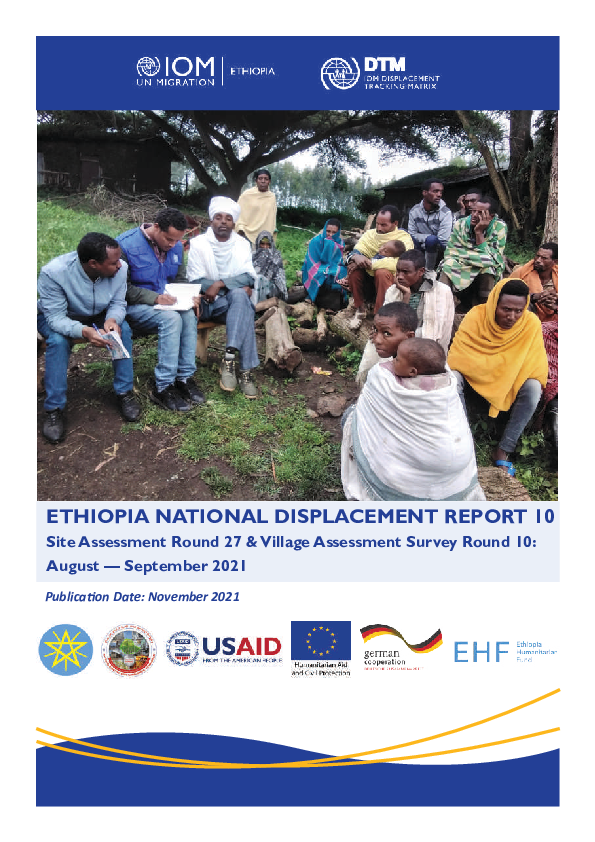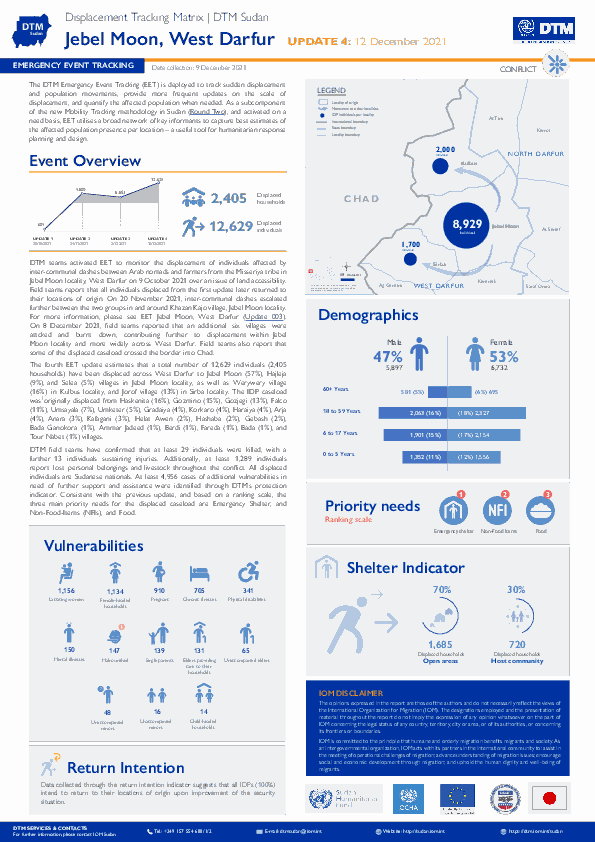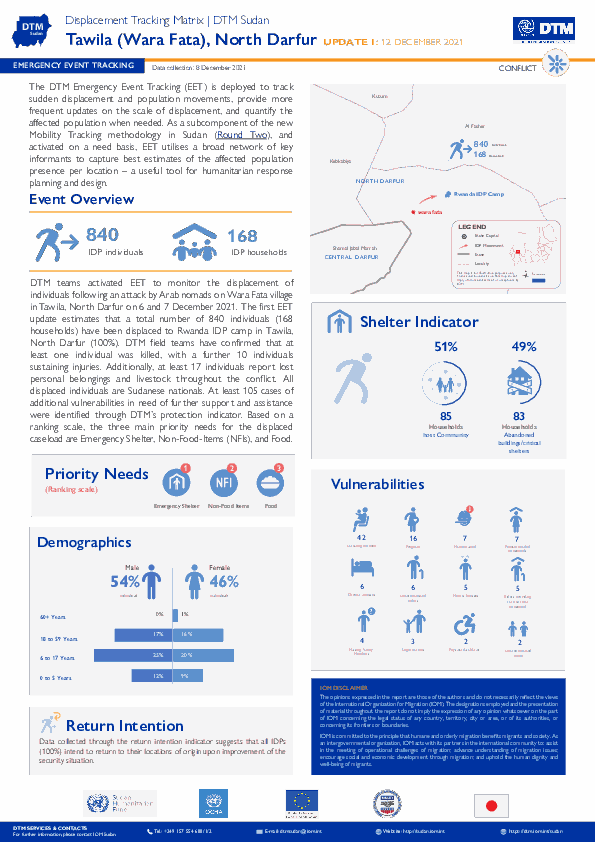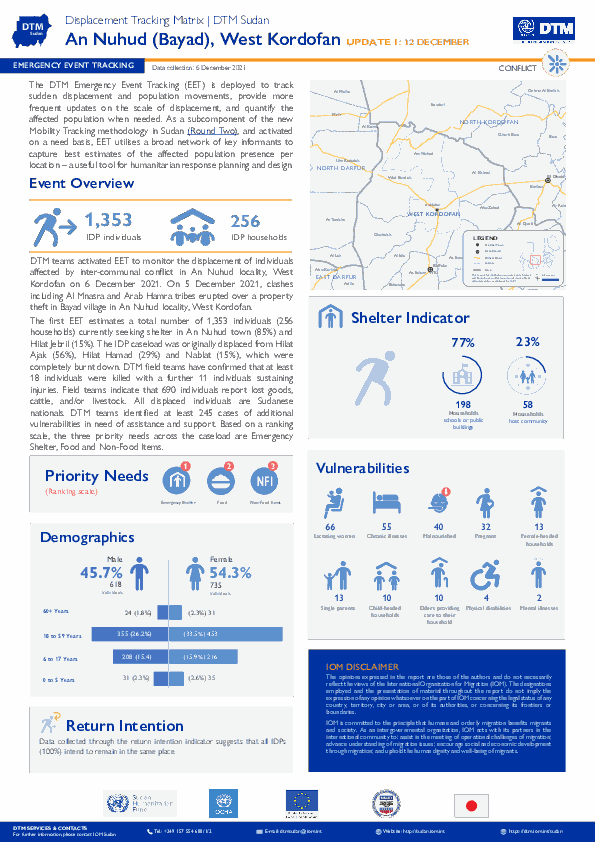-
Countries
-
Data and Analysis
-
Special Focus
-
Crisis Responses

Contact
DTM Ethiopia, SLOAddisAbabaDTM@iom.int
Language
English
Location
Ethiopia
Period Covered
Aug 15 2021
Sep 23 2021
Activity
- Site Assessment
- Mobility Tracking
- Village Assessment
In order to capture the displacement and return dynamics in Ethiopia, DTM Ethiopia's National Displacement Report combines findings from its Site Assessment (SA) in Section 1 and findings from the Village Assessment Survey (VAS) in Section 2. The Site Assessment tracks the number and multi sectoral needs of internally displaced persons (IDPs), while the Village Assessment Survey tracks the number of IDPs who are returning or have returned to their communities and their multi sectoral needs. VAS is also used to evaluate the absorption capacity of villages receiving returns with a focus on accessibility of services, livelihoods and reintegration.
As of September 2021, a total of 4.23 million IDPs have been identified thus far across the country. Through Site Assessment (SA), a total of 2.12 million IDPs were identified in 1,577 sites across 9 regions in Ethiopia. Simultaneously, 2.11 million IDPs were also tracked through the Emergency Site Assessment (ESA) round 8 which is a monthly tool used to track internal displacement in Tigray, Afar and Amhara regions caused by the Northern Ethiopia Crisis. Of the total displaced population, the main causes of displacement were conflict which displaced 3.5 million IDPs (85%), drought which displaced 307,871 IDPs (7%) and seasonal floods which displaced 139,199 IDPs (3%).
Through Village Assessment Survey, a total of 1.5 million returning IDPs were identified in 1,172 villages across 9 regions. A large majority of returning IDPs (1.4 million) were initially displaced due to conflict while 61,295 returning IDPs were initially displaced due to flash floods and 54,095 returning IDPs due to seasonal floods. The region hosting the largest number of returning IDPs was Oromia region with 653,549 returning IDPs, followed by Somali region with 392,286 returning IDPs. However, please note that there were considerable access and/or security issues in Amhara, Benishangul Gumz, Oromia and Tigray regions which affected the total displacement and return count.

Contact
DTM Sudan; dtmsudan@iom.int
Language
English
Location
Sudan
Snapshot Date
Dec 08 2021
Activity
- Event Tracking
- Mobility Tracking
The DTM Emergency Event Tracking (EET) is deployed to track sudden displacement and population movements, provide more frequent updates on the scale of displacement, and quantify the affected population when needed. As a subcomponent of the new Mobility Tracking methodology in Sudan (Round Two), and activated on a need basis, EET utilises a broad network of key informants to capture best estimates of the affected population presence per location – a useful tool for humanitarian response planning and design.

Contact
DTM Sudan; dtmsudan@iom.int
Language
English
Location
Sudan
Snapshot Date
Dec 08 2021
Activity
- Mobility Tracking
- Event Tracking
The DTM Emergency Event Tracking (EET) is deployed to track sudden displacement and population movements, provide more frequent updates on the scale of displacement, and quantify the affected population when needed. As a subcomponent of the new Mobility Tracking methodology in Sudan (Round Two), and activated on a need basis, EET utilises a broad network of key informants to capture best estimates of the affected population presence per location – a useful tool for humanitarian response planning and design.
Contact
DTM Yemen, iomyemendtm@iom.int
Location
Yemen
Activity
- Event Tracking
- Mobility Tracking
Period Covered
Dec 13 2021 -Nov 28 2021
From 01 January 2021 to 4 December 2021, IOM Yemen DTM estimates that 21,802 households (HH) (130,812 Individuals) have experienced displacement at least once.
Since the beginning of 2021, DTM also identified 3,814 displaced households who left their locations of displacement and either moved back to their place of origin or another location.
Between 28 November and 04 December 2021, IOM Yemen DTM tracked 234 households (1,404 individuals) displaced at least once.
The top three districts of the top three governorates that saw the highest number of displacements were:
• Taiz (66 HH) – Mawza (48 HH), Salah (6 HH), As Silw (5 HH) districts. Most displacements in the governorate were internal.
• Al Hodeidah (52 HH) – Hays (39 HH), Al Khukhah (13 HH) districts. Most displacements in the governorate were internal.
• Marib (50 HH) – Marib City (36 HH), Marib (14 HH) districts. Most displacements in the governorate were internal.
Most displacements resulted from the increased conflict in the following governorates and districts.
• Taiz (70 HH) – Maqbanah (57 HH), Sharab Ar Rawnah (3 HH), At Taiziyah (3 HH) districts.
• Al Hodeidah (59 HH) – Hays (21 HH), Al Jarrahi (17 HH), At Tuhayta (13 HH) districts.
• Marib (51 HH) – Al Jubah (23 HH), Harib (7 HH), Sirwah (7 HH) districts.
Population Groups
Survey Methodology
Unit of Analysis Or Observation
Type of Survey or Assessment
Keywords
Geographical Scope
Administrative boundaries with available data
The current dataset covers the following administrative boundaries
Contact
DTM Yemen, iomyemendtm@iom.int
Location
Yemen
Activity
- Event Tracking
- Mobility Tracking
Period Covered
Nov 21 2021 -Nov 27 2021
From 01 January 2021 to 27 November 2021, IOM Yemen DTM estimates that 21,392 households (HH) (128,352 Individuals) have experienced displacement at least once.
Since the beginning of 2021, DTM also identified 3,814 displaced households who left their locations of displacement and either moved back to their place of origin or another location.
Between 21 and 27 November 2021, IOM Yemen DTM tracked 259 households (1,554 individuals) displaced at least once. The top three districts of the top three governorates that saw the highest number of displacements were:
• Marib (91 HH) – Marib City (59 HH), Marib (32 HH) districts. Most displacements in the governorate originated from Marib and Shabwah.
• Al Hodeidah (55 HH) – Hays (55 HH) district. Most displacements in the governorate were internal.
• Taiz (46 HH) – Al Makha (10 HH), Jabal Habashi (7 HH), Al Qahirah (7 HH) districts. Most displacements in the governorate originated from Al Hodeidah and Taiz.
Most displacements resulted from the increased conflict in the following governorates and districts.
• Al Hodeidah (82 HH) – Hays (37 HH), Al Jarrahi (21 HH), Jabal Ras (6 HH) districts.
• Marib (66 HH) – Al Jubah (25 HH), Sirwah (14 HH), Harib (14 HH) districts.
• Shabwah (37 HH) – Ayn (22 HH), Bayhan (13 HH), Osaylan (2 HH) districts.
Population Groups
Survey Methodology
Unit of Analysis Or Observation
Type of Survey or Assessment
Keywords
Geographical Scope
Administrative boundaries with available data
The current dataset covers the following administrative boundaries
Contact
DTM Yemen, iomyemendtm@iom.int
Location
Yemen
Activity
- Event Tracking
- Mobility Tracking
Period Covered
Nov 14 2021 -Nov 20 2021
From 01 January 2021 to 20 November 2021, IOM Yemen DTM estimates that 21,007 households (HH) (126,042 Individuals) have experienced displacement at least once.
Since the beginning of 2021, DTM also identified 3,814 displaced households who left their locations of displacement and either moved back to their place of origin or another location.
Between 14 and 20 November 2021, IOM Yemen DTM tracked 497 households (2,982 individuals) displaced at least once. The top three districts of the top three governorates that saw the highest number of displacements were:
• Marib (202 HH) – Marib City (142 HH), Marib (60 HH) districts. Most displacements in the governorate were internal.
• Taiz (96 HH) – Al Makha (89 HH), Al Waziyah (7 HH) districts. All displacements in the governorate orginiated from Al Hodeidah.
• Al Maharah (55 HH) – Al Ghaydhah (52 HH), Sayhut (3 HH) districts. Most displacements in the governorate originated from Taiz and Ibb.
Most displacements resulted from the increased conflict in the following governorates and districts.
• Marib (203 HH) – Al Jubah (169 HH), Sirwah (12 HH), Harib (9 HH) districts.
• Al Hodeidah (169 HH) – At Tuhayta (82 HH), Hays (43 HH), Ad Durayhimi (17 HH) districts.
• Shabwah (34 HH) – Osaylan (19 HH), Bayhan (10 HH), Ayn (5 HH) districts.
Population Groups
Survey Methodology
Unit of Analysis Or Observation
Type of Survey or Assessment
Keywords
Geographical Scope
Administrative boundaries with available data
The current dataset covers the following administrative boundaries
Contact
DTM Cameroon, DTMCameroon@iom.int
Location
Cameroon
Activity
- Mobility Tracking
- Baseline Assessment
Period Covered
Jul 07 2021 -Jul 18 2021
A baseline assessment is a sub-component of mobility tracking. It aims to collect data on IDP, migrant or returnee population presence in a defined administrative area of the country.
Population Groups
Survey Methodology
Unit of Analysis Or Observation
Type of Survey or Assessment
Keywords
Geographical Scope
Administrative boundaries with available data
The current dataset covers the following administrative boundaries

Contact
iabdelgadir@iom.int
Language
English
Location
Sudan
Snapshot Date
Dec 09 2021
Activity
- Event Tracking
The DTM Emergency Event Tracking (EET) is deployed to track sudden displacement and population movements, provide more frequent updates on the scale of displacement, and quantify the affected population when needed. As a subcomponent of the new Mobility Tracking methodology in Sudan (Round Two), and activated on a need basis, EET utilises a broad network of key informants to capture best estimates of the affected population presence per location – a useful tool for humanitarian response planning and design.

Contact
DTM Sudan; dtmsudan@iom.int
Language
English
Location
Sudan
Snapshot Date
Dec 08 2021
Activity
- Event Tracking
- Mobility Tracking
The DTM Emergency Event Tracking (EET) is deployed to track sudden displacement and population movements, provide more frequent updates on the scale of displacement, and quantify the affected population when needed. As a subcomponent of the new Mobility Tracking methodology in Sudan (Round Two), and activated on a need basis, EET utilises a broad network of key informants to capture best estimates of the affected population presence per location – a useful tool for humanitarian response planning and design.

Contact
DTM Sudan; dtmsudan@iom.int
Language
English
Location
Sudan
Snapshot Date
Dec 06 2021
Activity
- Event Tracking
- Mobility Tracking
The DTM Emergency Event Tracking (EET) is deployed to track sudden displacement and population movements, provide more frequent updates on the scale of displacement, and quantify the affected population when needed. As a subcomponent of the new Mobility Tracking methodology in Sudan (Round Two), and activated on a need basis, EET utilises a broad network of key informants to capture best estimates of the affected population presence per location – a useful tool for humanitarian response planning and design.
